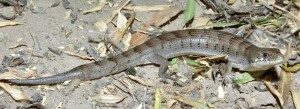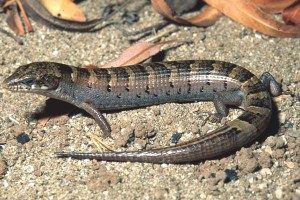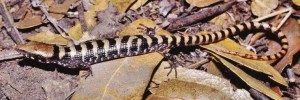[vc_row][vc_column][vc_column_text]
Madrean Alligator Lizard (Elgaria kingii)
[/vc_column_text][gap size=”12px” id=”” class=”” style=””][/vc_column][/vc_row][vc_row][vc_column width=”1/2″][vc_single_image image=”1552″ img_size=”large” alignment=”center” style=”vc_box_rounded”][vc_column_text]Madrean Alligator Lizard, Rancho El Aribabi, Sonora, MX. Photo by Jim Rorabaugh[/vc_column_text][/vc_column][vc_column width=”1/2″][vc_row_inner][vc_column_inner width=”1/2″][vc_single_image image=”1554″ img_size=”medium” alignment=”center” onclick=”img_link_large”][vc_column_text]Madrean Alligator Lizard, Rio Cocospera, Sonora, MX. Photo by Jim Rorabaugh[/vc_column_text][/vc_column_inner][vc_column_inner width=”1/2″][vc_single_image image=”1556″ img_size=”medium” alignment=”center” style=”vc_box_rounded” onclick=”img_link_large”][vc_column_text]Madrean Alligator Lizard, Santa Cruz County, AZ. Photo by Jim Rorabaugh[/vc_column_text][/vc_column_inner][/vc_row_inner][/vc_column][/vc_row][vc_row][vc_column width=”1/6″][/vc_column][vc_column width=”2/3″][vc_column_text]
Description
The town of Cave Creek (Maricopa Co., Arizona) was the center of my early herpetological explorations. Cave Creek road was a great night drive for snakes, the nearby hills had an abundance of mine tunnels harboring several species of rattlesnakes, abandoned homesteads littered the landscape with boards to turn, and just to the north lay Seven Springs with shade, a stream, and a diversity of riparian species.

Figure 1. Madrean Alligator Lizard (Elgaria kingii), Rancho El Aribabi, Sonora, MX. Photo by Jim Rorabaugh
On 23 May 1958, a friend and I stopped at Cave Creek and bought three cokes, one of which was for the town burro. The animal took the neck of the open bottle in its teeth, raised its head high, and drained the sweet cold liquid into its mouth. It was hot and we decided to continue on to Seven Springs and cool off in the stream. Near Camp Creek we noticed an old track branching off the main road and it beckoned us to explore. The track wound around a hill and ended at a small mine diggings. Grabbing our head lamps and snake sticks, we headed for the tunnel. The mine had collapsed at several points and ended abruptly in a vertical shaft that was heavy with the sweet musk of bats. We dropped a stone and the long time lapse before the splash underscored the danger of our reckless exploration and we retreated.
Emerging from the tunnel we were drawn to a tumbled down miner’s shack. Around it were strewn old boards that we eagerly turned and replaced. From under one of the pieces, a long, slender, shiny lizard streaked with serpentine locomotion, escaping into a small cluster of rocks. Turning the rocks uncovered a lizard the likes of which I had never seen. As I grasped the reptile, it latched onto my finger, twisted its body and tail around my hand, and defecated in grand style. The dorsum was marked with rich brown cross-bands, the sides of the body had folds, and the ventral scales were large and rectangular. This was before the western field guide came into existence, but I recognized from my previous readings of Stebbins’ 1954 book that I had encountered my first anguid, a Madrean Alligator Lizard (Elgaria kingii; Figures 1-3).

Figure 2. Madrean Alligator Lizard (Elgaria kingii), Cochise Co., Arizona. Photo by Cecil R. Schwalbe.
Eventually I became intrigued by the ecological distribution of the species. The core of its range appears to be the pine-oak and other high elevation woodlands of the Sierra Madre Occidental (e.g., McCranie and Wilson 1987). But in Arizona, it has been reported from a wide variety of communities: pine-oak and pinyon-oak-juniper woodlands in the Huachuca Mts. (Morrison et al. 1995); Madrean woodland and semi-desert grassland in the Whetstone Mts. (Turner et al. 2003); low, moderate, and high elevations in the Rincon Mts. (Flesch et al. 2010); 2690 m (8826 ft) elevation in the Chiricahua Mts. (Medica 1965); Sonoita Creek State Natural Area (Turner 2007); and closed chaparral and mixed broadleaf riparian woodland in central Arizona (Jones 1988). Amazingly, Lazaroff et al. (2006) found no evidence (including no museum records) of the occurrence of the species in Sabino Canyon (Santa Catalina Mts., Pima Co., Arizona) where their study area extended to 1016 m (3334 ft) elevation and included a rich riparian woodland with an abundance of rocks. At the eastern edge of its U.S. distribution in Doña Ana Co., New Mexico, it occurs in creosote bush desert scrub on Robledo Mtn. (Knight and Duerre 1987). Thus, over its range the species is found in a relatively broad spectrum of biotic communities from high elevation conifer forests to low elevation desert scrub. This wide ecological range may be facilitated by the buffered micro-habitat of this crepuscular and somewhat reclusive lizard, which is found under rocks, logs, dead sotols (Dasylirion wheeleri), and leaf litter.
The geographic distribution of the species also is somewhat unusual (Figure 4). The majority of the members of the Madrean herpetofauna that range into Arizona stop at or before a line that separates the Santa Rita Mts. from the Rincon Mts. (see discussions of the Madrean or Lowe’s line in Lowe 1991, Swann et al. 2005, Archie et al. 2006, and Flesch et al. 2010). However, the range of the Madrean Alligator Lizard continues north though the Rincon Mts. to the Mogollon Rim. It shares this biogeographic pattern to varying degrees with a few other Madrean species, such as the Canyon Treefrog (Hyla arenicolor), Arizona Treefrog (Hyla wrightorum), and Sonoran Mountain Kingsnake (Lampropeltis pyromelana).

Figure 3. Juvenile Madrean Alligator Lizard (Elgaria kingii), Santa Cruz Co., Arizona. Photo by Jim Rorabaugh.
In some instances the faunal change at Lowe’s line involves complementary species distributions, such as Lowe (1991) originally pointed out for the Arizona Black Rattlesnake (Crotalus cerberus) north of the line versus the Rock Rattlesnake (Crotalus lepidus), Ridge-nosed Rattlesnake (C. willardi), and Twin-spotted Rattlesnake (C. pricei) to the south. This is not the case for alligator lizards and the absence of other anguid species in most of the Southwest may be reflected in the northern reach of the distribution of E. kingii.
The species appears to occur in nearly all of the Arizona ranges of the Madrean Archipelago and in the San Rafael Valley and Sonoita grasslands (Figure 4). It is absent from most of the arid grasslands of the Sulphur Spring Valley, but present on rocky bajadas around the periphery (Rosen et al. 1996). It ranges north to Alpine (Apache Co.), Show Low (Navajo Co.), the Sierra Ancha, Pine (Gila Co.), Williams (Coconino Co.), and Prescott (Yavapai Co). Its distribution in central Arizona is not well documented and may be fairly discontinuous. For example, Hulse (1973) did not find the species in his survey of the Fort Apache Reservation.
Considering the well-documented vegetation changes in the Southwest over the last 40,000 years (Van Devender 1990), there is reason to expect that gene exchange may have occurred relatively recently among populations in the ranges of the Madrean Archipelago (Tennessen and Zamudio 2008). However, fairly large differences in mitochondrial DNA have been found among populations of the Canyon Treefrog (Barber 1999) and of the Striped Plateau Lizard (Sceloporus virgatus; Tennessen and Zamudio 2008), suggesting more ancient divergence in these non-nuclear genes. A detailed study of nuclear and mitochondrial gene sequences in populations of the Madrean Alligator Lizard throughout its range may help elucidate the biogeographic history of the species and the region.
The nearest relative of E. kingii was found on the basis of allozymes (Good 1988) to be the Panamint Alligator Lizard (E. panamintina), a similar appearing species occurring 400 km (240 mi) to the northwest in canyons of the Inyo, White, Panamint, and other ranges in the northern Mohave and western Great Basin deserts of California. However, recent DNA analyses place the Madrean Alligator Lizard as the sister species of the entire E. multicarinata (Southern Alligator Lizard) branch (clade) composed of four species found from the cape of Baja California Sur to the state of Washington (Wiens and Slingluff 2001, Conroy et al. 2005, Feldman and Spicer 2006).
Other than habitat, distribution, and systematics, few studies have been published on the Madrean Alligator Lizard. Goldberg (1975) examined the reproductive cycle and found that breeding takes place in the autumn, with yolk deposition beginning in October and ovulation occurring in April. This early start of ovulation may permit the species to lay multiple clutches per year. The autumn breeding cycle is unusual among Southwestern oviparous lizards (Goldberg 1975) and contrasts with the spring breeding cycle of the Southern Alligator Lizard (Elgaria multicarinata; Goldberg 1972). Cunningham (1958) reported that a female E. kingii collected on 24 July contained 9 eggs. Stebbins (1958) reported the observation of William Woodin that a captive female from Cochise Co., Arizona, laid 15 eggs on 5 June. Degenhardt et al. (1996) found a female in a rock crevice with 12 eggs in the process of hatching in August, suggesting the possibility of nest brooding in the species. Bowker (1986) described mating in captivity during which the male appeared to remain entwined around the female for 43 hrs.
Painter and Jennings (1998) published a photo of a nearly patternless adult female from Grant Co., New Mexico. The existence of sexual dimorphism in color pattern of the Madrean Alligator Lizard requires additional study. Webb (1970) stated that there is no marked secondary sexual variation in the species. However, Knight and Duerre (1987) present observations and a photograph indicating the existence of sexual dimorphism in color pattern in a small sample from New Mexico, males having broader bands with greater contrast than females. From their observations, the lizard in Figure 1 of this account may be a female; and that in Figure 2 may be a male. Juveniles have bands that are strongly contrasting (Figure 3).
Helminth parasites of Arizona specimens were examined by Goldberg et al. (1999) who found two species of cestodes and four species of nematodes, none of which is unique to Elgaria kingii. Brennan and Feldner (2002) report a maximum size record of 140 mm SVL for a male from the Blue Range, Greenlee Co., Arizona. Woodin (1953) reported the observation of a medium sized individual that had been caught in a spider web in the Huachuca Mts.
Over the species range from Jalisco to Sonora, Chihuahua, Arizona and New Mexico, three subspecies have been recognized, with Elgaria kingii nobilis Baird and Girard 1852 (Arizona Alligator Lizard) occurring in Arizona and New Mexico (Webb 1970). No type locality was designated in the original description of the species and it was restricted to Mojárachic, Chihuahua, by Smith and Taylor (1950). The derivation of the name Elgaria is speculative. The species is named for either Rear Admiral Philip Parker King who collected reptiles for the British Museum, or his son, Captain Philip Gedley King, who sailed with Charles Darwin on the Beagle.
Acknowledgments. I thank Don Swann for discussion, Erik Enderson and Cecil Schwalbe for use of images, Kit Bezy for help with the figures, and Kit Bezy and Kathryn Bolles for helpful suggestions on a previous version of this paper.
Literature Cited
Archie, J.W., R.L. Bezy, and E.F. Enderson. 2006. Yarrow’s Spiny Lizard (Sceloporus jarrovii Cope 1875): Lowe’s line revisited. Sonoran Herpetologist 19:50-53.
Barber, P. H. 1999. Phylogeography of the Canyon Tree Frog, Hyla arenicolor (Cope) based on mitochondrial sequence data. Molecular Ecology 8:547-562.
Brennan, T.C., and M. J. Feldner. 2002. Elgaria kingii nobilis: maximum size. Herpetological Review 33: 305-306.
Bowker, R.W. 1986. Gerrhonotus kingi: reproduction. Herpetological Review 17:20.
Conroy, C.J., R.W. Bryson, Jr., D. Lazcano and A. Knight. 2005. Phylogenetic placement of the Pygmy Alligator Lizard based on mitochondrial DNA. Journal of Herpetology 39:142-147.
Cunningham, J.D. 1958. Alligator lizard notes. Herpetologica 14:180.
Degenhardt, W.G., C.W. Painter, and A.H. Price. 1996. Amphibians and Reptiles of New Mexico. University of New Mexico Press, Albuquerque.
Feldman, C.R., and G. Spicer. 2006. Comparative phylogeography of woodland reptiles in California: repeated patterns of cladogenesis and population expansion. Molecular Ecology 15:2201-2222.
Flesch, A.D., D.E. Wilson, D.S. Turner, and B.F. Powell. 2010. Herpetofauna of the Rincon Mountains, Arizona. Southwestern Naturalist 55:240-253.
Goldberg, S.R. 1972. Reproduction in the Southern Alligator Lizard, Gerrhonotus multicarinatus. Herpetologica 28:267-273.
Goldberg, S.R. 1975. Reproduction in the Arizona Alligator Lizard, Gerrhonotus kingi. Southwestern Naturalist 20:412-413.
Goldberg, S.R., C.R. Bursey, and H. Cheam. 1999. Helminths of the Madrean Alligator Lizard, Elgaria kingii (Sauria: Anguidae), from Arizona. Great Basin Naturalist 59:198-200.
Good, D. M. 1988. Allozyme variation and phylogenetic relationships among the species of Elgaria (Squamata: Anguidae). Herpetologica 44:154-162.
Hulse, A.C. 1973. Herpetofauna of the Fort Apache Indian Reservation, east central Arizona. Journal of Herpetology 7:275-282.
Jones, K.B. 1988. Distribution and habitat associations of herpetofauna in Arizona: comparisons by habitat type. Pages 109-128 in: R.C. Szaro, K.E. Severson, and D.R. Patton (eds.), Management of Amphibians, Reptiles, and Small Mammals in North America. USDA Forest Service General Technical Report RM-166.
Knight, R.A., and D. Duerre. 1987. Notes on distribution, habitat, and sexual dimorphism of Gerrhonotus kingii (Lacertilia: Anguidae). Southwestern Naturalist 32:283-285.
Lazaroff, D.W., P.C. Rosen, and C.H. Lowe, Jr. 2006. Amphibians, reptiles, and their habitats at Sabino Canyon. University of Arizona Press, Tucson.
Lowe, C.H. 1991. On the biogeography of the herpetofauna at Saguaro National Monument. Pages 91-104 in: C.P. Stone and E.S. Bellantoni (eds.), Proceedings of a Symposium on Research in Saguaro National Monument. National Park Service, Southwest Parks and Monuments Association, Tucson, Arizona.
McCranie, J.R., and L.D. Wilson. 1987. The biogeography of the herpetofauna of the pine-oak woodlands of the Sierra Madre Occidental of México. Contributions in Biology and Geology 72:1-30.
Medica, P.A. 1965. Altitude record for Gerrhonotus kingi. Herpetologica 21:147-148.
Morrison, M.L., W.M. Block, L.S. Hall, and H.S. Stone. 1995. Habitat characteristics and monitoring of amphibians and reptiles in the Huachuca Mountains, Arizona. Southwestern Naturalist 40:185-192.
Painter, C.W., and R.D. Jennings. 1998. Elgaria kingii nobilis: coloration. Herpetological Review 29:238.
Rosen, P.C., S.S. Sartorius, C.R. Schwalbe, P.A. Holm, and C.H. Lowe. 1996. Herpetology of the Sulphur Springs Valley, Cochise County, Arizona. Pages 65-80 in: B. Tellman, D.M. Finch, C. Edminster, and R. Hamre (eds.), The Future of Arid Grasslands. USDA Forest Service RMRS-P-3.
Smith, H.M., and E.H. Taylor. 1950. An annotated checklist and key to the reptiles of Mexico exclusive of snakes. Smithsonian Institution United States National Museum Bulletin 199:i-v, 1-253.
Stebbins, R.C. 1954. Amphibians and Reptiles of Western North America. McGraw-Hill, New York.
Stebbins, R.C. 1958. A new alligator lizard from the Panamint Mountains, Inyo County, California. American Museum Novitates 1883:1-27.
Swann, D.E., T.M. Mau-Crimmins, and E.W. Stitt. 2005. In search of the Madrean line: biogeography of herpetofauna of the sky islands. Pages 149-153 in: G J. Gottfied, B.S. Gebow, L.G. Eskew, and C.B. Edminster (eds.), Connecting Mountain Islands and Desert Seas: Biodiversity and Management of the Madrean Archipelago II, 2004 May 11-15, Tucson. USDA Forest Service, Rocky Mountain Research Station Proceedings RMRS-P-36.
Tennessen, J.A., and K.R. Zamudio. 2008. Genetic differentiation among mountain island populations of the Striped Plateau Lizard, Sceloporus virgatus (Squamata: Phrynosomatidae). Copeia 2008:558-564.
Turner, D.S. 2007. Amphibians and reptiles of Sonoita Creek State Natural Area. Sonoran Herpetologist 20:38-42.
Turner, D.S., P.A. Holm, E.B. Wirt, and C.R. Schwalbe. 2003. Amphibians and reptiles of the Whetstone Mountains, Arizona. Southwestern Naturalist 48:347-355.
Van Devender, T.R. 1990. Late Quaternary vegetation and climate of the Sonoran Desert, United States and Mexico. Pages 134-163 in: J.L. Betancourt, T.R. Van Devender, and P.S. Martin (eds.), Packrat Middens: the Last 40,000 Years of Biotic Change. University of Arizona Press, Tucson.
Webb, R.G. 1970. Gerrhonotus kingii (Gray). Catalogue of American Amphibians and Reptiles 97.1-97.4.
Wiens, J. J., and J.L. Slingluff. 2001. How lizards turn into snakes: a phylogenetic analysis of body-form evolution in anguid lizards. Evolution 55:2303-2318.
Woodin, W.H. 1953. Notes on some reptiles from the Huachuca area of southeastern Arizona. Bulletin of the Chicago Academy of Science 9:285-296.
Author: Robert Bezy
Originlly published in the Sonoran Herpetologist 2011 24(7):66-69.
For more information see Sonoran Herpetologist 2017 30(4):72-80.[/vc_column_text][/vc_column][vc_column width=”1/6″][/vc_column][/vc_row][vc_row][vc_column][gap size=”30px” id=”” class=”” style=””][/vc_column][/vc_row]


